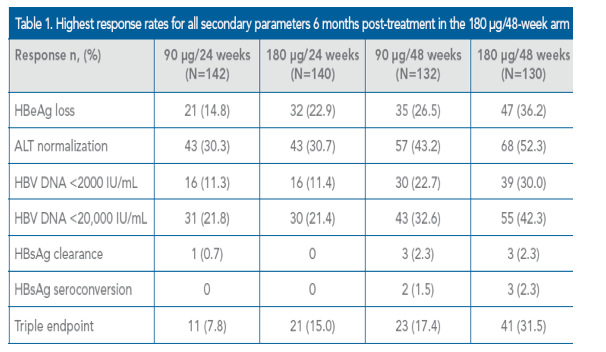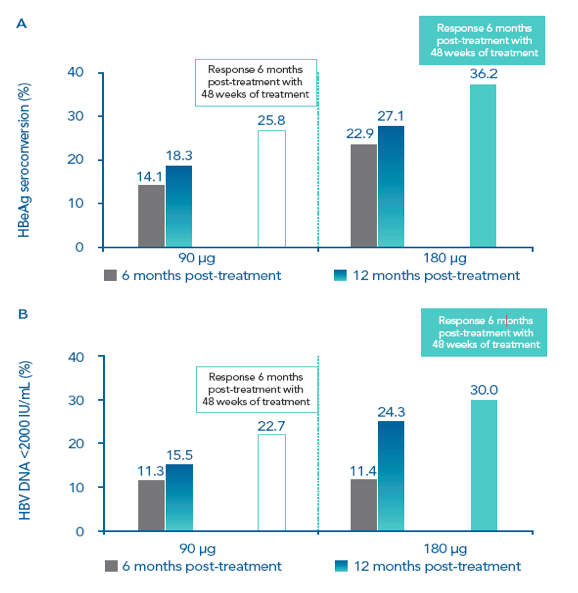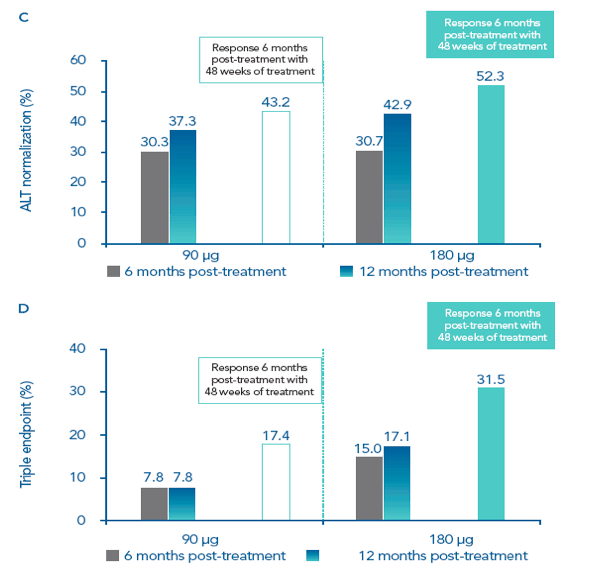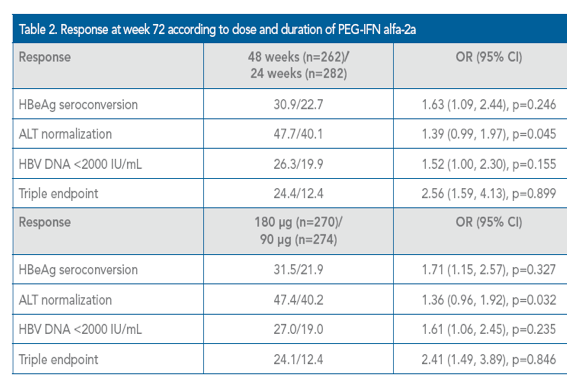 |
 |
 |
| |
Highest Rates of Response at Week 72 of the NEPTUNE Study are Achieved with Peginterferon Alfa-2a 180 μg for 48 weeks
|
| |
| |
Reported by Jules Levin
The 46th Annual Meeting of the European Association for the Study of the Liver (EASL), Berlin, Germany, March 30-April 3, 2011
P Marcellin,1 Q Xie,2 J Sung,3 T Tanwandee,4 KH Han,5 C Wat,6 C-W Hsu,7 J Jia8
1Service d'Hepatologie and Centre de Recherches Biologiques Beaujon (Inserm CRB3), University of Paris, Clichy, France; 2Department of Infectious Diseases, Ruijin Hospital, Shanghai, China; 3Department of Medicine and Therapeutics, Prince of Wales Hospital, Hong Kong; 4Department of Medicine, Siriraj Hospital, Mahidol University, Bangkok, Thailand;
5Department of Internal Medicine, Yonsei University College of Medicine, Seoul, Korea; 6Roche Products Ltd, Welwyn Garden City, UK; 7Liver Research Unit, Chang Gung Memorial Hospital and Chang Gung University College of Medicine Taipei, Taiwan; 8Beijing Friendship Hospital, Capital Medical University, Beijing, China
Author Summary
Rate of HBeAg seroconversion 6 months post-treatment was higher in the 180 μg/48-week arm than in the other treatment arms (36.2% compared with 14.1-25.8% in the other treatment arms)
Response to PEG-IFN alfa-2a is known to increase post-treatment6,7 and this was investigated in the 24-week treatment arms of the NEPTUNE study (the 1 year post-treatment time point had not been reached in the 48-week treatment arms). HBeAg seroconversion increased in the 24-week arms between 6 months and 1 year post-treatment. Rates of HBV DNA <2000 IU/mL and ALT normalization also increased between 6 months and 1 year post-treatment
Despite the increase in response rates in the 24-week treatment arms to 1 year post-treatment, they did not reach the levels achieved in the 48-week treatment arms 6 months post-treatment
For all efficacy parameters, 24 weeks of treatment were inferior to 48 weeks of treatment and 90 μg/week PEG-IFN alfa-2a was inferior to 180 μg/week
Author Conclusion
Shorter duration and lower doses of PEG-IFN alfa-2a were inferior to the 48-week duration and 180 μg/week dose at both 6 months post-treatment and week 72. Rates of response increased between 6 months and 12 months post-treatment in the 24-week treatment arms, but did not reach the levels achieved with 48 weeks of treatment at 6 months post-treatment. The NEPTUNE study confirms the licensed PEG-IFN alfa-2a regimen (180 μg/48 weeks) as the most efficacious and beneficial for HBeAg-positive patients compared with shorter durations and lower doses
Background
Peginterferon alfa-2a (40 KD; PEG-IFN alfa-2a; PEGASYS) has proven efficacy in hepatitis B e antigen (HBeAg)-positive chronic hepatitis B (CHB)1 and is recommended as a first-line therapy for CHB by all international treatment guidelines2-5
Although the licensed dose and duration of PEG-IFN alfa-2a is 180 μg/week for 48 weeks in all countries, there is currently a lack of consensus on the most appropriate dose and duration, which is reflected in varying recommendations in international guidelines
The NEPTUNE study was designed to compare different treatment regimens (90 μg/week or 180 μg/week for 24 or 48 weeks) to establish the most appropriate treatment regimen for PEG-IFN alfa-2a in HBeAg-positive patients
The primary endpoint of the NEPTUNE study was response 6 months post-treatment; however, response was also assessed at week 72 (equivalent to 12 months post-treatment in patients treated for 24 weeks and 6 months post-treatment in patients treated for 48 weeks). It is known that HBeAg seroconversion increases post-treatment in HBeAg-positive patients.6,7 In the NEPTUNE study, the 72-week time point provides an indication of longer term response in patients treated for 24 weeks
Objective
The aim of the NEPTUNE study was to compare the efficacy and safety of PEG-IFN alfa-2a given for either 24 or 48 weeks and at doses of either 90 μg/week or 180 μg/week. The current analysis investigated whether response rates increased during longer term follow up of the 24-week treatment arms
Methods
This was a phase 4, double-blind, randomized, multicenter trial with a 2 x 2 factorial design. HBeAg-positive patients were randomized (1:1:1:1) to PEG-IFN alfa-2a (90 μg/week or 180 μg/week for 24 or 48 weeks) by
subcutaneous injection once weekly (Figure 1). Patients were stratified by screening alanine aminotransferase (ALT) levels: upper limit of normal (ULN)-2 x ULN; 2-5 x ULN; 5-10 x ULN and viral genotype (A, B, C + other genotypes and D)

Efficacy parameters assessed were HBeAg seroconversion, HBeAg loss, ALT normalization (< ULN), HBV DNA <2000 IU/mL, HBV DNA <20,000 IU/mL, HBsAg clearance, HBsAg seroconversion and a triple
endpoint of HBeAg seroconversion, ALT normalization and HBV DNA <20,000 IU/mL
All endpoints were assessed at 6 months post-treatment and at a 72-week time point - this was equivalent to 6 months post-treatment for the 48-week treatment arms and 1 year post-treatment for the 24-week treatment arms
Statistical analysis
The null hypotheses were that 24 weeks of treatment is inferior to 48 weeks of treatment and 90 μg/week is inferior to 180 μg/week. The primary test statistic was odds ratio (OR) with a non-inferiority margin
pre-specified as 1.88. OR 48/24 or 180/90 was significant if the upper 95% confidence interval (CI) was <1.88 at the significance level of 0.025 and the null hypothesis would be rejected
Results
Highest rates of HBeAg seroconversion 6 months post-treatment were achieved in the 180 μg/48-week arm (36.2%; Figure 2), which is the licensed dose and duration for PEG-IFN alfa-2a

Highest response rates for all secondary parameters 6 months post-treatment were also achieved in the 180 μg/48-week treatment arm (Table 1)

The 72-week time point provides longer term follow-up data in the 24-week treatment arms - the equivalent to 1 year post-treatment. Response rates increased from 6 months to 1 year post-treatment for each parameter, but did not reach the levels achieved 6 months post-treatment with 48 weeks of therapy (Figure 3)
- For HBeAg seroconversion, response rates increased from 14.1% to 18.3% in the 90 μg/24-week arm and from 22.9% to 27.1% in the 180 μg/24-week arm. At week 72, response rates in the 90 μg/48-week and 180 μg/48-week arms were 25.8% and 36.2%, respectively
Highest rates of response at week 72 were achieved in the 180 μg/48-week treatment arm HBsAg clearance was achieved at week 72 by one patient in the 90 μg/24-week arm, none of the patients in the 180 μg/24-week arm, three patients in the 90 μg/48-week arm and three patients in the 180 μg/48-week arm
Figure 3. Response rates increased between 6 months and 1 year post-treatment in the 24-week treatment arms, but do not reach levels achieved in the 48-week treatment arms 6 months post-treatment. A HBeAg seroconversion; B. HBV DNA <2000 IU/mL; C. ALT normalization; D. Triple endpoint


Inferiority analysis
For all efficacy parameters at week 72, the upper 95% confidence interval was >1.88 and, therefore, the p-value of non-inferiority was not significant and the null hypothesis was retained. Consequently, we can conclude that 24 weeks of therapy were inferior to 48 weeks
of therapy and 90 μg/week was inferior to 180 μg/week (Table 2)

References
1. Lau GKK et al. Peginterferon alfa-2a, lamivudine, and the combination for HBeAg-positive chronic hepatitis B. New Engl J Med 2005;352:2682-95
2. European Association for the Study of the Liver. EASL clinical practice guidelines: management of chronic hepatitis B. J Hepatol 2009;50:227-42
3. Liaw YF et al. Asian-Pacific consensus statement on the management of chronic hepatitis B: a 2008 update. Hepatol Int 2008;2:263-83
4. Lok A, McMahon B. Chronic hepatitis B. Hepatology 2007;45:507-39
5. Lok A, McMahon B. Chronic hepatitis B: update 2009. Hepatology 2009;50:1-2
6. Lau G et al. Durability of response and occurrence of late response to peginterferon alfa-2a (40KD) [PEGASYS] one year post-treatment in patients with HBeAg-positive chronic hepatitis B. Presented at: 41st Annual Meeting of the European Association for the Study of the Liver (EASL); April 26-30, 2006; Vienna, Austria
7. Piratvisuth T et al. Sustained response to peginterferon alfa-2a (40KD) with or without lamivudine in Asian patients with HBeAg-positive and HBeAg-negative chronic hepatitis B. Hepatol Int 2008; 2:102-110
|
| |
|
 |
 |
|
|